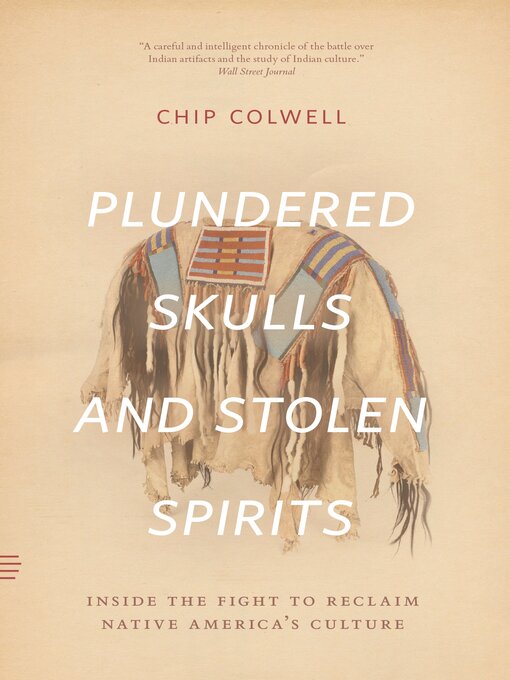Who owns the past and the objects that physically connect us to history? And who has the right to decide this ownership, particularly when the objects are sacred or, in the case of skeletal remains, human? Is it the museums that care for the objects or the communities whose ancestors made them? These questions are at the heart of Plundered Skulls and Stolen Spirits, an unflinching insider account by a leading curator who has spent years learning how to balance these controversial considerations.
Five decades ago, Native American leaders launched a crusade to force museums to return their sacred objects and allow them to rebury their kin. Today, hundreds of tribes use the Native American Graves Protection and Repatriation Act to help them recover their looted heritage from museums across the country. As senior curator of anthropology at the Denver Museum of Nature & Science, Chip Colwell has navigated firsthand the questions of how to weigh the religious freedom of Native Americans against the academic freedom of scientists and whether the emptying of museum shelves elevates human rights or destroys a common heritage. This book offers his personal account of the process of repatriation, following the trail of four objects as they were created, collected, and ultimately returned to their sources: a sculpture that is a living god, the scalp of a massacre victim, a ceremonial blanket, and a skeleton from a tribe considered by some to be extinct. These specific stories reveal a dramatic process that involves not merely obeying the law, but negotiating the blurry lines between identity and morality, spirituality and politics.
Things, like people, have biographies. Repatriation, Colwell argues, is a difficult but vitally important way for museums and tribes to acknowledge that fact—and heal the wounds of the past while creating a respectful approach to caring for these rich artifacts of history.
Plundered Skulls and Stolen Spirits
Inside the Fight to Reclaim Native America's Culture
-
Creators
-
Publisher
-
Release date
March 8, 2017 -
Formats
-
Kindle Book
-
OverDrive Read
- ISBN: 9780226299044
- File size: 1636 KB
-
EPUB ebook
- ISBN: 9780226299044
- File size: 1636 KB
-
-
Languages
- English
-
Reviews
-
Publisher's Weekly
January 9, 2017
Colwell, senior curator of anthropology at the Denver Museum of Nature & Science, explores the fraught project of repatriating Native American sacred objects in this moving and thoughtful work. Drawing on his personal experiences navigating the repatriation process, as well as interviews with tribal leaders, Colwell outlines the historical, legal, and political entanglements surrounding the theft and eventual recovery of sacred items once displayed in American museums. Each of the book’s four sections focuses on artifacts belonging to a different Native people, tracing the respective repatriation journeys of Zuni sculptures that are also living gods, body parts from Cheyenne and Arapaho victims of the Sandy Creek massacre, a ceremonial Tlingit robe, and bones of the Calusa, whose extinction remains debated. With each story, Colwell attends to tensions between museum preservationists and living Native communities, emphasizing that repatriation is not an act, but a complex, emotional process. Along the way, he skillfully interweaves discussion of the Native American Graves Protection and Repatriation Act, which paved the way for coordinated Native recovery efforts. Colwell’s book raises provocative questions about who owns the past, and is surely an important work for curators—or anyone—interested in America’s treatment of its cultural legacy. -
Library Journal
January 1, 2017
During the 1800s, museums and universities amassed collections of cultural artifacts and remains of "exotic peoples," including Native Americans and Native Hawaiians. The federal government acknowledged that the remains of some Native Americans were being violated through the passage of the Antiquities Act of 1906, but the legislation proved largely symbolic. The Native American Graves Protection and Repatriation Act of 1990 (NAGPRA) finally gained Native peoples the right to have their sacred objects and remains of ancestors returned to them. Since its passage, NAGPRA has been criticized by some researchers who argue that the law has impaired scientific study by denying access to research materials. Colwell (senior curator of anthropology, Denver Museum of Nature and Science) has been caught in the maelstrom caused by NAGPRA as he had to find a way to protect his museum's collection while also meeting the legal and moral obligations to various Native communities. He demonstrates that the repatriation is not as simple as weighing freedom of religion vs. intellectual freedom, as there are even conflicts among Native groups over who is the rightful recipient of items or remains. VERDICT This work is highly recommended for readers interested in Native American studies or museums.--John R. Burch, Campbellsville Univ. Lib., KY
Copyright 2017 Library Journal, LLC Used with permission.
-
Formats
- Kindle Book
- OverDrive Read
- EPUB ebook
subjects
Languages
- English
Loading
Why is availability limited?
×Availability can change throughout the month based on the library's budget. You can still place a hold on the title, and your hold will be automatically filled as soon as the title is available again.
The Kindle Book format for this title is not supported on:
×Read-along ebook
×The OverDrive Read format of this ebook has professional narration that plays while you read in your browser. Learn more here.


